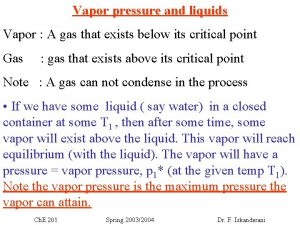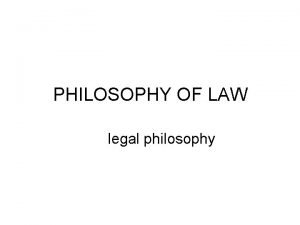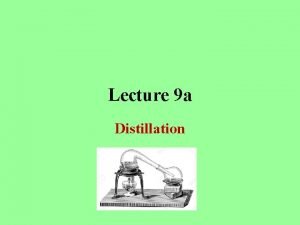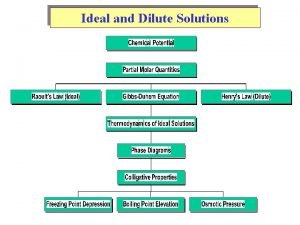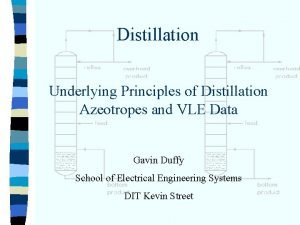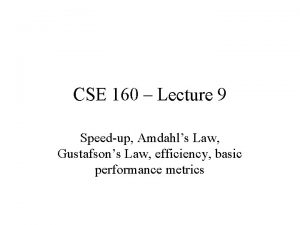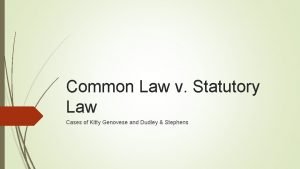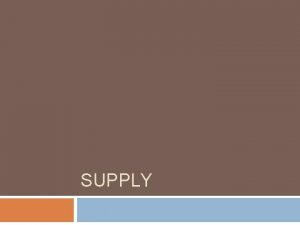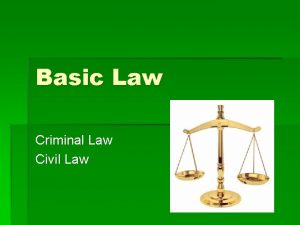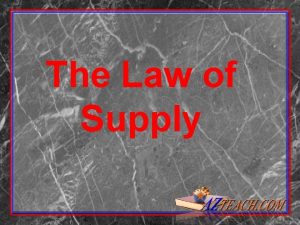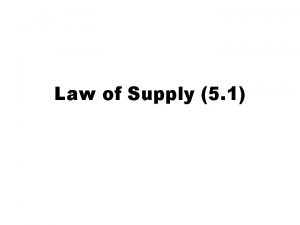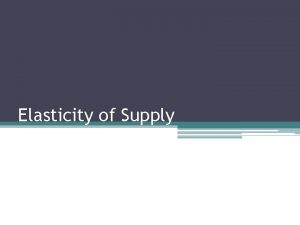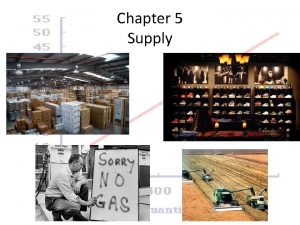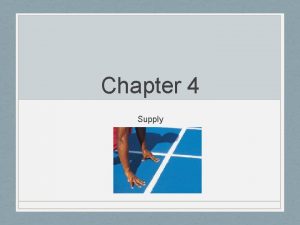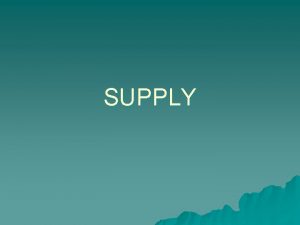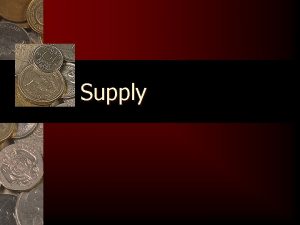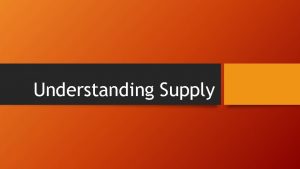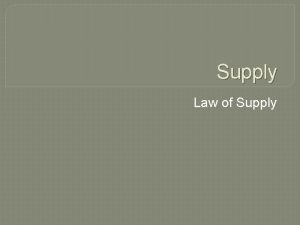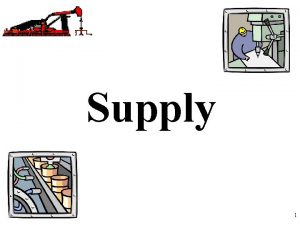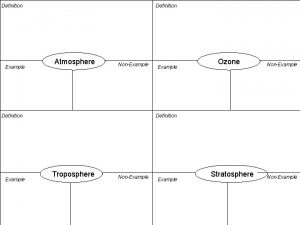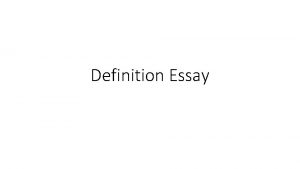SUPPLY Definition of Supply Law of Supply Supply






















- Slides: 22

SUPPLY Definition of Supply: Law of Supply: Supply Function: Assumptions of Law of Supply: Limitations/Exceptions of Law of Supply: Importance of Law of Supply: Determinants of Supply:

Supply is the scarce goods. It is the amount of a commodity that sellers are able and willing to offer for sale at different price per unit of time. In the words of Meyer: “Supply is a schedule of the amount of a good that would be offered for sale at all possible price at any period of time; e. g. , a day, a week, and so on”.

Definition of Law of Supply: There is direct relationship between the price of a commodity and its quantity offered for sale over a specified period of time. When the price of a goods rise, other things remaining the same, its quantity which is offered for sale increases as and price falls, the amount available for sale decrease. This relationship between price and the quantities which suppliers are prepared to offer for sale is called the law of supply.

Supply Function: The supply function is now explained with the help of a schedule and a curve. Market Supply Schedule: Market Supply Schedule of a Commodity:

In the table above, the producer are able and willing to offer for sale 100 units of a commodity at price of $5. As the price falls, the quantity offered for sale decreases. At price of $1, the quantity offered for sale is only 20 units.

Law of Supply Curve/Diagram: The market supply data of the commodity x as shown in the supply schedule is now presented graphically.

In the figure (5. 1) price is plotted on the vertical axis OY and the quantity supplied on the horizontal axis OX. The five points e, d, c, b, and a show each price quantity combination. The supply curve SS/ slopes upward from left to right indicating that less quantity is offered for sale at lower price and more at higher prices by the sellers not supply curve is usually positively sloped.

Formula for Law of Supply/Supply Function: The supply function can also be expressed in symbols. Qx. S = Φ (Px Tech, Si, Fn, X, . . . . ) Here: Qxs = Quantity supplied of commodity x by the producers. Φ = Function of. Px = Price of commodity x. Tech = Technology.

Si = Supplies of inputs. Fn = Features of nature. X = Taxes/Subsidies. () = Bar on the top of last four non-price factors indicates that these variables also affect the supply but they are held constant.

Example of Law of Supply: The law of supply is based on a moving quantity of materials available to meet a particular need. Supply is the source of economic activity. Supply, or the lack of it, also dictates prices. Cost of scarce supply goods increase in relation to the shortages. Supply can be used to measure demand. Over supply results in lack of customers. An over supply is often a loss, for that reason under supply generates a demand in the form of orders, or secondary sales at higher prices. If ten people want to buy a pen, and there's only one pen, the sale will be based on the level of demand for the pen. The supply function requires more pens, which generates more production to meet demand.

Assumptions of Law of Supply: (i) Nature of Goods. If the goods are perishable in nature and the seller cannot wait for the rise in price. Seller may have to offer all of his goods at current market price because he may not take risk of getting his commodity perished. (ii) Government Policies. Government may enforce the firms and producers to offer production at prevailing market price. In such a situation producer may not be able to wait for the rise in price.

(iii) Alternative Products. If a number of alternative products are available in the market and customers tend to buy those products to fulfill their needs, the producer will have to shift to transform his resources to the production of those products. (iv) Squeeze in Profit. Production costs like raw materials, labor costs, overhead costs and selling and administration may increase along with the increase in price. Such situations may not allow producer to offer his products at a particular increased price.

Limitations/Exceptions of Law of Supply: Exceptions that affect law of supply may include: (i) Ability to move stock. (ii) Legislation restricting quantity. (iii) External factors that influence your industry.

Importance of Law of Supply: (i) Supply responds to changes in prices differently for different goods, depending on their elasticity or inelasticity. Goods are elastic when a modest change in price leads to a large change in the quantity supplied. In contrast, goods are inelastic when a change in price leads to relatively no response to the quantity supplied. An example of an elastic good would be soft drinks, whereas an example of an inelastic service would be physicians' services.

(ii) Law of supply is an economic principle that states that there is a direct relationship between the price of a good and how much producers are willing to supply. (iii) As the price of a good increases, suppliers will want to supply more of it. However, as the price of a good decreases, suppliers will not want to supply as much of it. For producers to want to produce a good, the incentive of profit must be greater than the opportunity cost of production, the total cost of producing the good, which includes the resources and value of the other goods that could have been produced instead.

(iv) Entrepreneurs enter business ventures with the intention of making a profit. A profit occurs when the revenues from the goods a producer supplies exceeds the opportunity cost of their production. However, consumers must value the goods at the price offered in order for them to buy them. Therefore, in order for a consumer to be willing to pay a price for a good higher than its cost of production, he or she must value that good more than the other goods that could have been produced instead.

So supplier's profits are dependent on consumer demands and values. However, when suppliers do not earn enough revenue to cover the cost of production of the good, they incur a loss. Losses occur whenever consumers value a good less than the other goods that could have been produced with the same resources.

Determinants of Supply: When the supply of the commodity rises or falls due to non-price determinants, the supply is said to have increased supply or decreased supply. The increases or decrease or the rise or fall in supply may take place on account of various factors. They are briefly stated as below:

(i) Changes in Factor Price. The rise of fall in supply may take place due to changes in the cost of production of a commodity. If the prices of various factor of production used in the production of a particular commodity increase of it total cost of production. There will be reduction in the supply of that commodity at each price because the amount demanded decreases with a rise in price. Conversely, if the prices of the various factors of production fall down, it will result in lowering the cost of production and so an increase in the supply on varying prices.

(ii) Changes in Technique. The supply of a commodity may also be affected by progress in technique. If an improvement in technique takes place in a particular industry, it will help in reducing its cost of production. This will result in greater production and so an increase in the supply of the commodity. The supply curve will shifts to the right of the original supply curve. (iii) Improvement in the Means of Transport. The supply of the commodity may also increase due to improvement in the means of communication and transport. If the means of transport are cheap and fast, then supply of the commodity can be increased at a short notice at lower price.

(iv) Climatic Changes in case of Agricultural Products. The supply of agricultural products is directly affected by the weather conditions and the use of the better methods of production. If rain is timely plentiful welldistributed; and improve methods of cultivation are employed then other things remaining the same, there will be bumper crops. It would then be possible to increase the supply of the agriculture products. (v) Political Changes. The increase or decrease in supply may also place due to political disturbances in a country. If country wages wars against another country or some kind of political disturbances take place just as we had at the time of partition, then the channels of production are disorganized. It results in the decrease of certain goods the supply curve shifts to the left of originals curve.

(vi) Taxation Policy. If a government levies heavy taxes on the import of particular commodities, then the supply of these commodities is reduced at each price. The supply curve shifts to the left. conversely if the taxes on output in the country are low and government encourages the import of foreign commodities, then the supply can be increased easily. The supply curve shifts to the right of originals supply curve. (vii) Goals of firms. If the firms expect higher profits in the future, they will take the risk and produce goods on large scale resulting in larger supply of the commodities. The supply curve shifts to the right.
 Newton's first law and second law and third law
Newton's first law and second law and third law Si unit of newton's first law
Si unit of newton's first law Boyle's law charles law avogadro's law
Boyle's law charles law avogadro's law P=k/v
P=k/v Chapter 5 section 1 supply and the law of supply
Chapter 5 section 1 supply and the law of supply Raoult's law and dalton's law
Raoult's law and dalton's law What is a civil law
What is a civil law Programl
Programl Legal realism
Legal realism Stoicism natural law
Stoicism natural law Mendel's law of dominance
Mendel's law of dominance 4-7 law of sines and cosines
4-7 law of sines and cosines Natural law vs positive law
Natural law vs positive law Difference between fractional and simple distillation
Difference between fractional and simple distillation Criminal law plaintiff
Criminal law plaintiff Raoult's law and dalton's law
Raoult's law and dalton's law Law of independent assortment vs law of segregation
Law of independent assortment vs law of segregation Faraday's law
Faraday's law Faraday's law vs lenz's law
Faraday's law vs lenz's law Lenz law
Lenz law Raoult's law vs dalton's law
Raoult's law vs dalton's law Amdahl's law vs gustafson's law
Amdahl's law vs gustafson's law Difference between common law and statute law
Difference between common law and statute law





